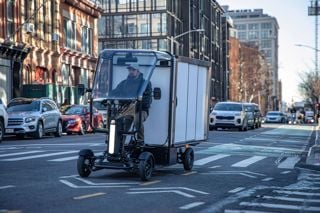
Gaining control of how staff travel on business can achieve significant cost, environmental and duty of care benefits for a fleet.
The first step in doing this is often for companies to introduce a travel policy, which includes a hierarchy stipulating preferred methods of
transport for different journeys and requirements.
“The reality is that a travel policy means different solutions for different fleets,” says Helen Fisk, product development and strategy manager at ALD Automotive.
“The objective is to run fleets more efficiently, reduce costs, lower CO2 and manage risk while maintaining driver satisfaction with more time to do their job.
“Once a fleet has agreed its travel plan, effective
communication with the driver and the means to monitor the way they travel are paramount to its success.”
A further method used by fleets to achieve success is the creation of a travel portal or bureau which employees can use to book or request travel.
These tend to either operate through an online system or a dedicated phone line.
In 2012, Sussex Community NHS Foundation Trust rebranded its fleet department as a travel bureau, which is essentially “a one-stop shop for staff and managers to review their travel”, says Jim Thomas, head of logistics at the organisation.
Its creation followed the introduction of a business travel plan which outlined ways to reduce the cost – both financial and environmental – of the trust’s travel: in 2012/13, staff covered almost six million business miles at a cost of almost £3 million.
“Because we travel millions of miles a year, we knew that it would take a relatively low percentage of people changing their mode of travel to save a lot of money for the trust,” says Thomas.
“The whole concept of the travel bureau is based around telling our employees that ‘we are not telling you how to do your job, we know you need to travel because we are a community trust, but we reckon we can help you to travel smarter’.
“Essentially, we invite people to contact us on a generic trust email address or a phone number which comes through to the team.”
Using the travel bureau provides employees with access to a range of initiatives, such as a pool car fleet of 16 low emission vehicles, information on and booking of public transport, and route planning.
“We’ve worked with clinical staff who have maybe started working in a new area and are given a list of 10 or 12 patients to visit,” says Thomas. “They may just work their way down that list in the order given, but what we can do is use software like Autoroute to plot the patients in a different order to reduce the miles our employees need to travel.
“We’ve also got pool cars based at key sites and, as part of our sustainable travel campaign, we are getting people to think about coming into work in other ways than their car, such as by bike or on public transport, knowing they can take one of our vehicles if they need to travel during their working day.”
The trust’s travel policy and bureau have dramatically reduced its grey fleet mileage: it fell 17% – or 949,500 miles – between 2013/14 and 2014/15. Based on an average
reimbursement of 50 pence per mile, that is almost £500,000.
Thomas says the travel bureau has also reduced parking pressures at its 65 sites.
“We are just making it as easy as possible for our employees to rethink their travel,” he adds.
The main way staff have so far been encouraged to use the travel bureau has been through communications, although Thomas is now engaging with cost centre managers to make it a more formal part of the trust’s operations.
Ricoh UK (see panel above) found that the creation of its online travel portal allowed it to clamp down on people “going under the radar,” says Chris Haynes, the company’s fleet and business travel manager.
“What I mean by that is employees thinking ‘I know I’m not going to get the hotel I’d prefer if I was booking it through travel, so what I will do is book it using my own credit card and claim it back through expenses’.
“We’ve had a real think about how we manage that because we want to be able to report on travel all in one place, but we also have a duty of care to know where people are at any one point in time, so if there’s a natural disaster or worse, then we can ensure we know where people are.
“We had a clampdown where we said ‘any travel that you’ve booked and claim back on expenses will be rejected and you will have to pay for it yourself’.
“That’s reversed the trend, so now we are getting 99% of all travel going through the travel portal.”
Fisk says using technology such as driver portals provided by suppliers can ensure a travel plan is adhered to by employees. “Using telematics and a vehicle mileage expense system where drivers can submit validated mileage journeys through an automated approval process, prohibited journey methods can be refused and drivers will not be reimbursed,” she adds.
Case study: Ricoh UK
The introduction of an online travel portal at Ricoh UK has reduced administration and given the company greater control over the cost and methods of staff transport.
“We had a process where staff had to fill out a form, then scan it in and send it over to the travel team who would book everything and then send the confirmation to that employee,” says Chris Haynes, fleet and business travel manager at Ricoh.
“Under the travel policy, if a request was above a certain price point, the form would have to be forwarded to their manager, they would have to reply, and so on and so forth.
“A manager could be seeing 20 of these requests a day and they may not have had the time to look at them, or they were on their mobiles and having to look at these tiny forms which were handwritten most of the time: it was a very manual process.”
In 2014, the technology company replaced this system with an online travel portal aimed primarily at non-company car drivers and company car drivers who wanted to use an alternative form of transport.
Employees can make requests for hotels, trains, rental cars, ferries, flights and airport parking.
“Now the employee has to send a simple email saying where that person is going from and to, and, more importantly, the purpose and reason for travel,” says Haynes.
“The team will pick up the request and we will use our preferred partners to source the hotel or hire car, so it’s simply for requests, the employee doesn’t book the travel themselves.”
The online portal still features an upper cost limit, but anything over that amount triggers an email to the line manager or – depending on the cost – board director, with ‘accept’ or ‘reject’ buttons.
The data created by the travel portal allows Haynes’s team to report on everything from supplier through to reason for travel through to cost.
“It has really changed the approach by making it more streamlined and improving the process,” he adds.
The portal also allows his team to suggest alternative travel arrangements to staff to reduce cost and CO2 emissions, such as car-sharing, changing train times, or using video-conferencing technology.





















Login to comment
Comments
No comments have been made yet.